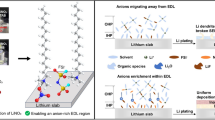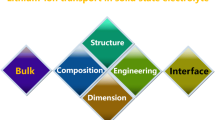Abstract
In the present work, a new boron-based room-temperature ionic liquid (BBRTIL) is reported. An ionic liquid based on the boron cation was synthesized by an easy metathesis procedure yielding clean products. The composition, thermal behavior, physical, and electrochemical properties of the BBRTIL were identified by nuclear magnetic resonance spectra (NMR), Fourier transform infrared (FTIR) thermogravimetric analysis (TGA), linear sweep voltammetry (LSV), and cyclic voltammetry (CV), respectively. NMR and FTIR have confirmed the structure formation of 0.3–0.4-mm-sized B2O3-based BBRTIL. Furthermore, the correlation between the electrochemical stability and the identified electrolyte equilibrium species was investigated via voltammetry. This procedure, in the future, could be an original alternative to the deposition of elemental boron through easy, one-step synthesis from high-temperature molten salt electrolysis.










Similar content being viewed by others
References
Holbrey JD, Seddon KR (1999) Ionic liquids. Clean Prod Processes 1(4):223–236
MacFarlane D, Pringle JM, Howlett PC, Forsyth M (2010) Ionic liquids and reactions at the electrochemical interface. Phys Chem Chem Phys 12:1659–1669
Petkovic M, Seddon K, Pereira C (2011) Ionic liquids: a pathway to environmental acceptability. Chem Soc Rev 40:1383–1403
Ranke J, Stolte S, Stoermann R, Arning J, Jastorff B (2007) Design of sustainable chemical products: the example of ionic liquids. Chem Rev 107:2183–2206
Reed CA (1998) Carboranes: a new class of weakly coordinating anions for strong electrophiles, oxidants, and superacids. Acc Chem Res 31(3):133–139
Bell RT, Strange NA, Leick N, Stavila V, Bowden ME, Autrey TS, Gennett T (2021) Mg(BH4)2-based hybrid metal-organic borohydride system exhibiting enhanced chemical stability in melt. ACS Appl Energy Mater 4(2):1704–1713
Panja SK, Saha S (2013) Recyclable, magnetic ionic liquid bmim[FeCl4]-catalyzed, multicomponent, solvent-free, green synthesis of quinazolines. RSC Adv 3(34):14495–14500
Lombardo L, Yang H, Züttel A (2018) Study of borohydride ionic liquids as hydrogen storage materials. J Energy Chem 33:17–21
Ghosh S, Singh T (2019) Role of ionic liquids in organic-inorganic metal halide perovskite solar cells efficiency and stability. Nano Energy S2211–2855(19):30528–30532
Wang K, Zhang Y, Chand D, Parrish DA, Shreeve JM (2012) Boronium-cation-based ionic liquids as hypergolic fluids. Chem-A European J 18(52):16931–16937
Kar M, Tutusaus O, MacFarlane DR, Mohtadi R (2019) Novel and versatile room-temperature ionic liquids for energy storage. Energy Environ Sci 12:566–571
Dziedzic RM, Waddington MA, Lee SE, Kleinsasser J, Plumley JB, Ewing WC, Spokoyny AM (2018) Reversible silver electrodeposition from boron cluster ionic liquid (BCIL) electrolytes. ACS Appl Mater Interfaces 10(8):6825–6830
Fareghi-Alamdari R, Ghorbani-Zamani F, Shekarriz M (2015) Surface passivation of bare boron nanoparticles using new dicyanamide-based dicationic ionic liquid. Energy Fuels 30(1):551–559
Tutusaus O, Mohtadi R, Arthur TS, Mizuno F, Nelson EG, Sevryugina YV (2015) An efficient halogen-free electrolyte for use in rechargeable magnesium batteries. Angew Chem Int Ed 54(27):7900–7904
Bürchner M, Erle AM, Scherer H, Krossing I (2012) Synthesis and characterization of boronate ionic liquids (BILs). Chem-A Eur J 18(8):2254–2262
Hanst PL, Early VH, Klemperer W (1965) Infrared spectrum and molecular structure of B2O3. J Chem Phys 42(3):1097–1104
Piers WE, Bourke SC, Conroy KD (2005) Borinium, borenium, and boronium ions: synthesis, reactivity, and applications. Angew Chem Int Ed 44:5016–5036
Kolle P, Noth H (1985) The chemistry of borinium and borenium ions. Chem Rev 85:399–418
Davis JH Jr et al (2013) Boronium based ionic liquids: salts of boron centered cations as promising salts for electrochemical applications. ECS Trans 50:293
Guo Y, Zhang F, Yang J, Wang F, NuLi Y, Hirano S (2012) Boron-based electrolyte solutions with wide electrochemical windows for rechargeable magnesium batteries. Energy Environ Sci 5:9100–9106
Polyakova LP, Bukatova GA, Polyakov EG, Christensen E, von Bjerrum BJH (1996) Electrochemical behavior of boron in LiF-NaF-KF- melts. J Electrochem Soc 143(10):3178
Polyakova LP, Bukatova GA, Polyakov EG, Cristensen E, von Barner JH, Bjerrum NJ (1995) Cathodic processes during the boron reduction in fluoride melts. Ehlektrokhimiya 31(12):1348–1353
Brookes HC, Gibson PS, Hills GJ, Narayan N, Wigley DA (1976) The electrochemistry of the boriding of ferrous metal surfaces. Transactions of the IMF 54(1):191–195
Bukatova GA, Kuznetsov SA, Gaune-Escard M (2007) Electrochemical synthesis of rare-earth metal (Eu, Nd) borides in molten salts. Russ J Electrochem 43:929–935
Effenberger H, Lengauer CL, Parthé E (2001) Trigonal B2O3 with Higher Space-Group Symmetry: Results of a Reevaluation. In: Monatshefte für Chemie, 132(12):1515-1517. https://doi.org/10.1007/s007060170008
Karadağ A, Destegul A (2013) N-(2-hydroxyethyl)-ethylenediamine-based ionic liquids: synthesis, structural characterization, thermal, dielectric and catalytic properties. J Mol Liq 177:369–375
Shah FU, Glavatskih S, Dean PM, MacFarlane DR, Forsyth M, Antzutkin ON (2012) Halogen-free chelated orthoborate ionic liquids and organic ionic plastic crystals. J Mater Chem 22(14):6928
Dean PM, Pringle JM, MacFarlane DR (2010) Structural analysis of low melting organic salts: perspectives on ionic liquids. Phys Chem Chem Phys 12(32):9144
Nemukhin AV, Weinhold F (1993) Boron oxides: ab initio studies with natural bond orbital analysis. J Chem Phys 98(2):1329
Myat H, Myo L, Pho K, Sein H (2006) Infrared Spectroscopic Study on the Structure of Ag2O. B2O3 Glasses. J Myanmar Acad Arts Sci. Vol. IV. No. 2
Bilgiç G, Şahin M, Kaplan H (2020) A System Design for Large Scale Production of Elemental Boron by Electrochemical Deposition. J Electrochem Soc. 167(16)
Horopanitis EE, Perentzis G, Pavlidou E et al (2003) Electrical properties of lithiated boron oxide fast-ion conducting glasses. Ionics 9:88–94
Concha BM, Chatenet M, Maillard F, Lima TEA, FHB, Lima RB, (2010) In situ infrared (FTIR) study of the mechanism of the borohydride oxidation reaction. Phys Chem Chem Phys 12(37):11507
Pascuta P, Borodi G, Bosca M, Pop L, Rada S, Culea E (2009) Preparation and structural characterization of some Fe2O3- B2O3-ZnO glasses and glass ceramics. J Phys Conf Ser 182(1):012072
Aghili S, Panjepour M, Meratian M (2018) Kinetic analysis of formation of boron trioxide from thermal decomposition of boric acid under non-isothermal conditions. J Therm Anal Calorim 131:2443–2455
Jadhav HS, Cho MS, Kalubarme RS, Lee JS, Jung KN, Shin KH, Park CJ (2013) Influence of B2O3 addition on the ionic conductivity of Li1.5Al0.5Ge1.5(PO4)3 glass ceramics. J Power Sources 241:502–508
Yuan WL, Yang X, He L, Xue Y, Qin S, Tao GH (2018) Viscosity, conductivity, and electrochemical property of dicyanamide ionic liquids. Front Chem 6:59
Devyatkin SV, Kaptay G (2002) Physical, chemical, and electrochemical behavior of boron oxide in cryolite alumina melts. Russ J Appl Chem 75(4):5653568
Kuznetsov SA (1996) Electroreduction of boron in chloride-fluoride melts. Elektrokhimiya 32(7):829–835
Makyta M, Matiašovský K, Fellner (1984) Mechanism of the cathode process in the electrolytic boriding in molten salts. Electrochim Acta 29(12):1653–1657
Segers L, Fontana A, Winand R (1991) Electrochemical boriding of iron in molten salts. Electrochim Acta 36(1):41–47
Matsuda H, Ayabe Y (1955) The theory of the cathode-ray polarography of Randles-Sevcik, Zeitschrift fuer Elektrochmie and Angewandte Physikalische. Chemie 59:494–503
Delahay P (1954) New instrumental methods in electrochemistry: theory, instrumentation, and applications to analytical and physical chemistry with a chapter on high-frequency methods by Charles N. Reilley. Foreword by I.M. Kolthoff. Published in New York (N.Y.): Interscience publishers.
Acknowledgements
The authors of this study thank the Technical Research Council and Scientific of Turkey (TUBİTAK, Career Development Program 3501; Grant KBAG-120Z175) for financial support. Also, the authors thank everyone who provided assistance, critical comments, and suggestions during the preparation of the manuscript.
Author information
Authors and Affiliations
Corresponding author
Additional information
Publisher's note
Springer Nature remains neutral with regard to jurisdictional claims in published maps and institutional affiliations.
Rights and permissions
About this article
Cite this article
Bilgiç, G., Korkmaz, N., Şahin, M. et al. Synthesis, structural, and electrochemical properties of boron-based ionic liquid. Ionics 28, 3289–3300 (2022). https://doi.org/10.1007/s11581-022-04575-7
Received:
Revised:
Accepted:
Published:
Issue Date:
DOI: https://doi.org/10.1007/s11581-022-04575-7




